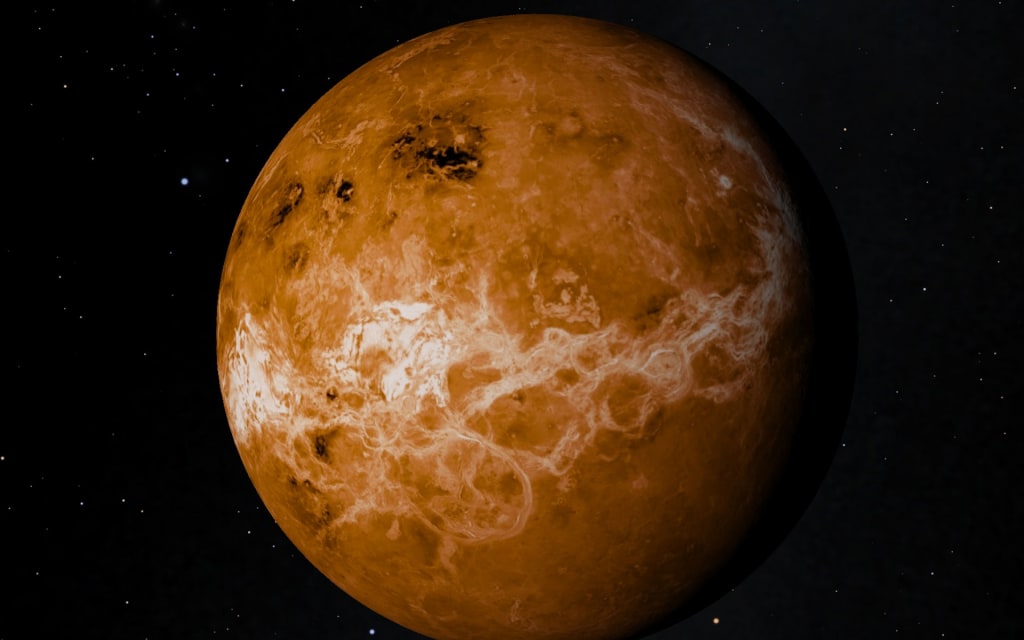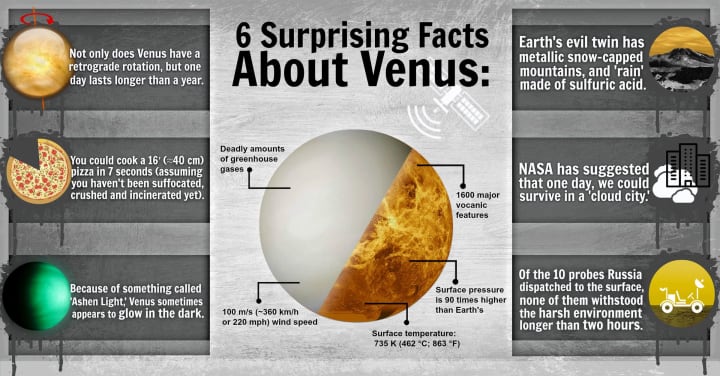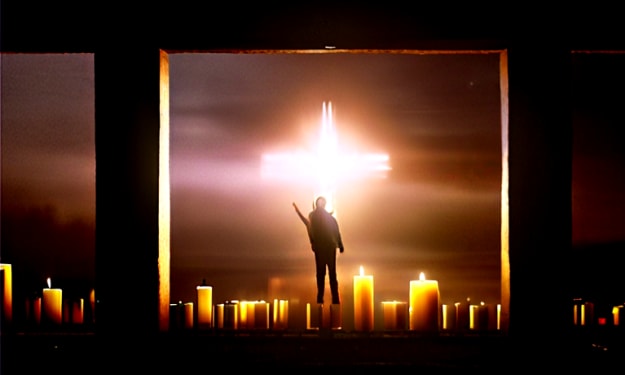Can We Live on Venus?
The answer to 'can we live on Venus?' may be decided by science and fiction.

Floating cities on Venus; it sounds like something Hugo Gernsback would have published in the pulp era of science fiction, but colonizing the second planet from the sun may not be as impossible as is widely believed. Despite Dantean-like surface conditions with temperatures that can melt lead, and atmospheric pressure equal to being under 3,000 feet of water, there remains a plausible place humanity might be able to exist—not on the surface but in the atmosphere above.
There is a "Goldilocks" spot some fifty miles above the surface of Venus. Not too cold, not too hot and with a pressure equal to Earth, this area provides what may just be humanity’s best bet for permanent colonization of another world... or space. This idea was recently resurrected by noted science fiction author Charles Stross in a blog post suggesting billionaires ought to pay for a floating city in the Venusian atmosphere.
Notwithstanding the implausibility of prying the needed trillions of dollars from the grips of the .01%, the idea itself appears viable, at least in the long term future. A fellow science fiction author, who also happens to be a scientist, named Geoffrey Landis proposed a compelling precis for such a project at the Conference on Human Space Exploration, Space Technologies & Applications in 2003. In this paper he pointed out that, unlike Earth, a nitrogen-oxygen mix of breathable air would actually float in Venus’s carbon dioxide heavy atmosphere.

Simply put, human colonists could use life-sustaining air on Venus like we use helium on Earth.
This means that the atmosphere of a sizable city could act as both life support and lifting gas. This drastically increases the potential size of a habitat we could build in which to permanently reside. Aside from the multiplication of feasible size, such a city would have other benefits. Due to the pressure of the atmosphere at this altitude, catastrophic decompression of these cities is not at risk. Any tear in the skin of the city would merely cause the air to leak out over the course of thousands of hours. Gasses tend to find homeostasis. On Mars or in space the pressure differential would cause a rapid, catastrophic loss of oxygen. Repairs on Venus could be made by the colonists, and the colony would therefore require less external support. Moreover, unlike Mars or open space, the gravity of Venus is 9/10th that of Earth, This means our colonists wouldn’t suffer the bone and muscular degradation that plagues long-term microgravity inhabitation.
While anyone venturing outside the dome would have to wear protective clothes against the acidic content of the atmosphere, that very atmosphere blocks radiation. No radiation shielding would be needed in this colony. There are also valuable resources which could be extracted from the atmosphere and, eventually, from the surface.
It’s likely these resources would serve as one impetus to build such an ambitious project. Make no mistake, these resources would either have to be vital to Earth or immensely profitable. This poses one of the major obstacles to this project—money. We lost the Space Age some time ago. As a country, our dreams of human exploration of the stars crumbled with the Berlin Wall and the architecture of ray gun gothic gas stations along Route 66. The internet helped kill our notions of the “future” as being space-based as well. Big data has, to some extent, replaced dreams of space colonization.
Today, exploration on other worlds takes the form of robots roaming across the surface of Mars and telescopes probing the distant past of the universe looking for its secrets. These are noble pursuits, but they lack the visceral satisfaction of human exploration experienced since the dawn of sea travel.
Colonizing Venus could bring this back and cause the birth of a new Space Age.
This has practical value as well, Stephen Hawking has long argued that the only long term survival strategy for the human species is to colonize other worlds. Eventually, some planet-killing asteroid or nuclear apocalypse may bring about the end of human life on Earth. It would be handy to have back ups on another planet who carry mankind into the future. Likewise, overpopulation may eventually force us off-world, and the size of Venus itself would allow billions of cities, each with populations in the hundreds of thousands, to float on that alien sky.
Obstacles still remain. Extracting oxygen from the Venusian atmosphere would be difficult. Jonothan Goff, who founded the space enthusiast blog Selenian Boondocks provides a forum where both amateurs and experts can discuss such possibilities. They also discuss how we might mine the surface itself. Sadly, this would likely be done with robots piloted by telepresence used remotely by the colonists above. Probes the Russians set down on Venus during the Cold War lasted only a matter of minutes before being crushed like a beer can on the head of a frat boy. Putting people on the surface is still highly unlikely.
Yet Venus remains a mythical, supernatural entity our ancestors venerated before the dawn of civilization. Exploration is what we do, what we have always done. We exist in a time that’s de-prioritized that extraterrestrial search in favor of going inside virtual worlds, but this isn’t likely to always be the case. One day there may be floating cities on Venus who celebrate and remember the place from which they came: Earth, a planet rendered uninhabitable by catastrophe and abandoned by its children. But humanity would still exist, out there, floating on Venus, the new launching pad for the race’s exploration of the universe. All we need is the will to do it.
Floating Cities in Science Fiction
Perhaps the race to colonize planets such as Mars, or in the future build floating cities around Venus will be inspired by science fiction. From Issac Asimov books to Neill Blomkamp films, is certainly seems like science fiction can predict the future. The visual spectacles provided from great sci-fi fanfare ignite the imagination and spark ingenuity.
Elysium is a science fiction movie from the writer and director Neill Blomkamp, of District 9. Set in the year 2054, the earth is overpopulated and polluted. Earth’s elite decide to abandon the surface and build a giant space station city called Elysium that floats inside earth’s orbit. The rest of the beleaguered population are left behind to fend for themselves and are not allowed to enter Elysium, ever.
Elysium is a dazzling, pristine city that has a utopian feel to it. It’s completely enclosed and many miles above the wasted Earth, in effect stranding the non-elites. Any unauthorized shuttle attempting to land is likely to be destroyed along with its passengers and crew.
This is the second episode in the first Star Wars trilogy. The rebel alliance has been forced to move their base to the ice planet Hoth. While investigating what appeared to be a meteor strike, Han Solo and Chewbacca instead come across a probe droid that alerts the Imperial Fleet to their presence. With no chance of holding the new base, Han, Leia and Chewbacca escape to Bespin where they meet up with an old friend of Han, Lando Calrissian. Meanwhile, Luke and R2-D2 escape to the swamp planet Degobah where Luke meets Yoda and becomes his Jedi pupil. Darth Vader and his imperial forces eventually catch up to Han and Leis and plans to use them as bait to lure Luke into rescuing them.
Back at Degobah, Luke is in the midst of training when he has a vision that Han and Leia are in pain. Without Yoda’s consent, Luke and R2-D2 take off in his X-Wing fighter. Cloud City is a gas mining colony that floats above the gas giant Bespin with the help of an anti-gravity pod.
Astro Boy is set in the futuristic Metro City, hovering over a polluted Earth. The film’s protagonist is a robot named Toby who is created in the likeness of Dr. Tenma’s son who died in an accident that he was responsible for. The robot Toby is ultimately rejected by his father/creator and goes off to find his place in the world where he meets up with a group of human children and a robot repairman named Hamegg. Astro Boy eventually reunites with his father and must save Metro City from a rampaging super robot, The Peacekeeper.
Metro City is depicted in the movie as a large hovering airship with futuristic buildings. As in Elysium, the poor inhabitants of the planet were not allowed to join the elites in Metro City.
Flash Gordon is a 1980 British space opera based on the original comic strip of the same name. Ming the Merciless from the planet Mongo is intent on destroying the earth. Football star “Flash” Gordon unintentionally ends up on a rocket ship to Mongo with Dr. Zarkov and travel reporter Dale Arden. Once there, they are immediately captured by Ming’s henchmen and must find a way to escape and save the earth. Along the way, Dale is kidnapped by Ming who intends to marry her, Ming’s amorous daughter Princess Aura falls for Flash and Dr. Zarkov must avoid “reprogramming”. Flash must unite the warring factions and find a way to stop the natural disasters before the earth is annihilate. The soundtrack was performed by rock supergroup Queen. The floating city that Prince Barin retreats to with Flash and Aura is Arboria and appears as a floating forest.
Howl’s Moving Castle is a 2004 Japanese animated film. Sophie, a beautiful eighteen year old girl who works in her mother’s hat shop, is one day turned into an old hag by the spiteful Witch of the Waste. Ashamed how she looks and unable to tell anyone, she flees into the hills and finds a strange walking castle. It belongs to the young and handsome Howl. Inside she meets the fire Demon Calcifer who wants her to help break the contract he has with Howl. In return, he will help free her of the Witch's curse. The moving castle in this movie is more like a medieval village that has feet and “walks”, essentially floating.
Castle in the Sky is a 1986 Japanese animated film. One day Pazu, a young engineer’s apprentice, sees a mysterious girl floating down from the sky. He catches her in his arms and thus sets in motion a journey to discover the secret of her levitation pendant and find the mythical floating castle, Lputa. Along the way, they must avoid pirates and government secret agents with their own designs on the floating castle.
Set in an alternate century Europe, Steamboy is a 2004 Japanese animated film. Ray, a brilliant young English inventor in the 1860’s, receives a mysterious package from his grandfather. Within it is a “steam” ball with schematics and instructions to guard it. Two men from the “O’hara Foundation” show up and try to steal it, but Ray escapes with the new technology. Ray then meets the granddaughter of the head chairman of the O’hara Foundation and gets a tour of a castle run by an army of engineers. Using the latest steam technology, it is completely powered by three steam balls. Ray must keep the steam balls out of the hands of the O’hara Foundation and their secret plans for them. The engineer’s castle is later lifted into the sky with the compressed air from one of the steam balls.
About the Creator
Chris Lites
Masters Degree in Writing and Publishing from DePaul University. Book reviewer at The Rumpus. Short stories available on Amazon.






Comments
There are no comments for this story
Be the first to respond and start the conversation.